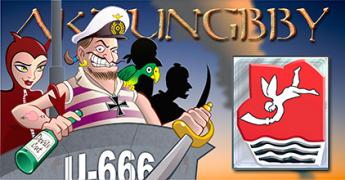 03-20-24, 12:03 AM
03-20-24, 12:03 AM
|
#3
|
|
Gefallen Engel U-666
Join Date: Jul 2013
Location: On a tilted, overheated, overpopulated spinning mudball on Collision course with Andromeda Galaxy
Posts: 27,895
Downloads: 22
Uploads: 0
|

https://www.ibiblio.org/hyperwar/USN...51/ASW-10.html
Quote:
|
In order to have for study a large number of convoys with serious exposure to submarines, it is necessary to deal with North Atlantic convoys, whose maximum speed was about 9½ knots. Data on these convoys for the 6-month period from August 1942 through January 1943 are presented in Table 1. During this period 80 to 110 U-boats were operating in the North Atlantic and convoy losses were high. A plausible explanation of the different effects of speed on eastbound and westbound convoys follows: Eastbound convoys being farther north received better air cover since aircraft flew from Iceland. Consequently U-boats operating against them had to spend a larger fraction of their time submerged. The mean speed of U-boats is therefore less when attacking eastbound than westbound convoys. Consequently the increase of speed from 7 to 91/2 knots may be a critical range and give large loss reduction for eastbound convoys, though not for westbound. This line of reasoning is confirmed by the fact that aircraft made 40 attacks on U-boats in connection with eastbound convoys and only 5 with westbound.
|
https://www.usni.org/magazines/naval...y-role-convoys
Quote:
|
Fast convoys usually zig zagged to complicate the U-boats’ targeting solutions, while slower and larger convoys usually steamed straight ahead because zig zagging further reduced speed and often caused confusion when used with a large number of ships. Individual ships sometimes used “evasive courses” (steering 20 to 40 degrees off base course) within the convoy if they were able. Larger convoys also increased the effectiveness of their escorts because the perimeter increased by only the square root of the total number of merchant ships. Warships escorting the convoy, under an escort commander, would set up a screen about three to four miles from the convoy’s perimeter, ideally positioned so that their radar and visual ranges overlapped. If there were enough escorts available, a second group would precede the convoy at about five to nine miles distance, using radar and sonar to sweep ahead. For a successful depth-charge attack, escorts relied on a tight turning circle to enable them to quickly get their sterns over a detected target, and they used their superior speed to allow them to continue prosecuting an attack on a U-boat and then catch up to their advancing convoy.
|
__________________

"Only two things are infinite; The Universe and human squirrelyness; and I'm not too sure about the Universe"
Last edited by Aktungbby; 03-20-24 at 12:11 AM.
|

|

|